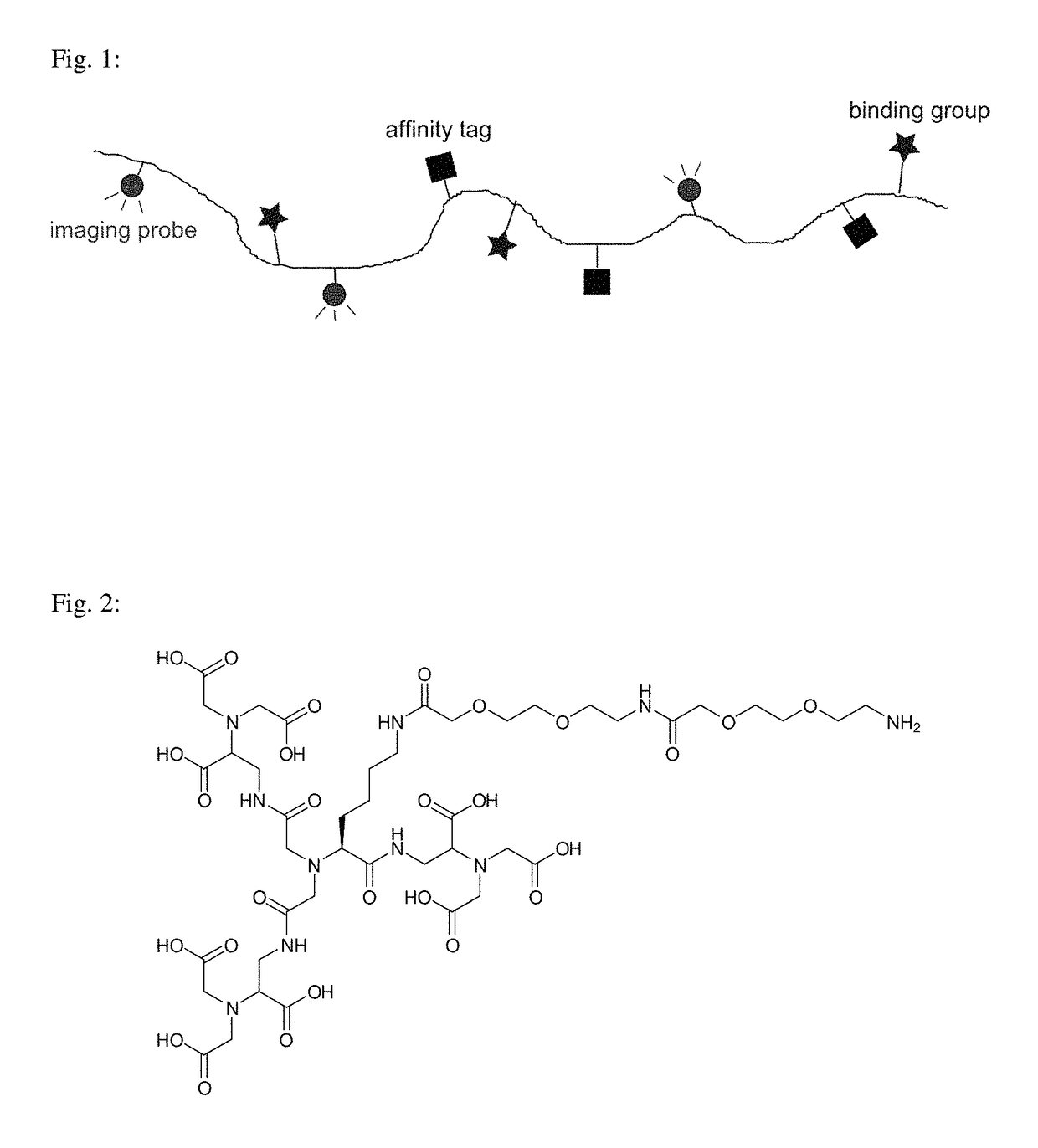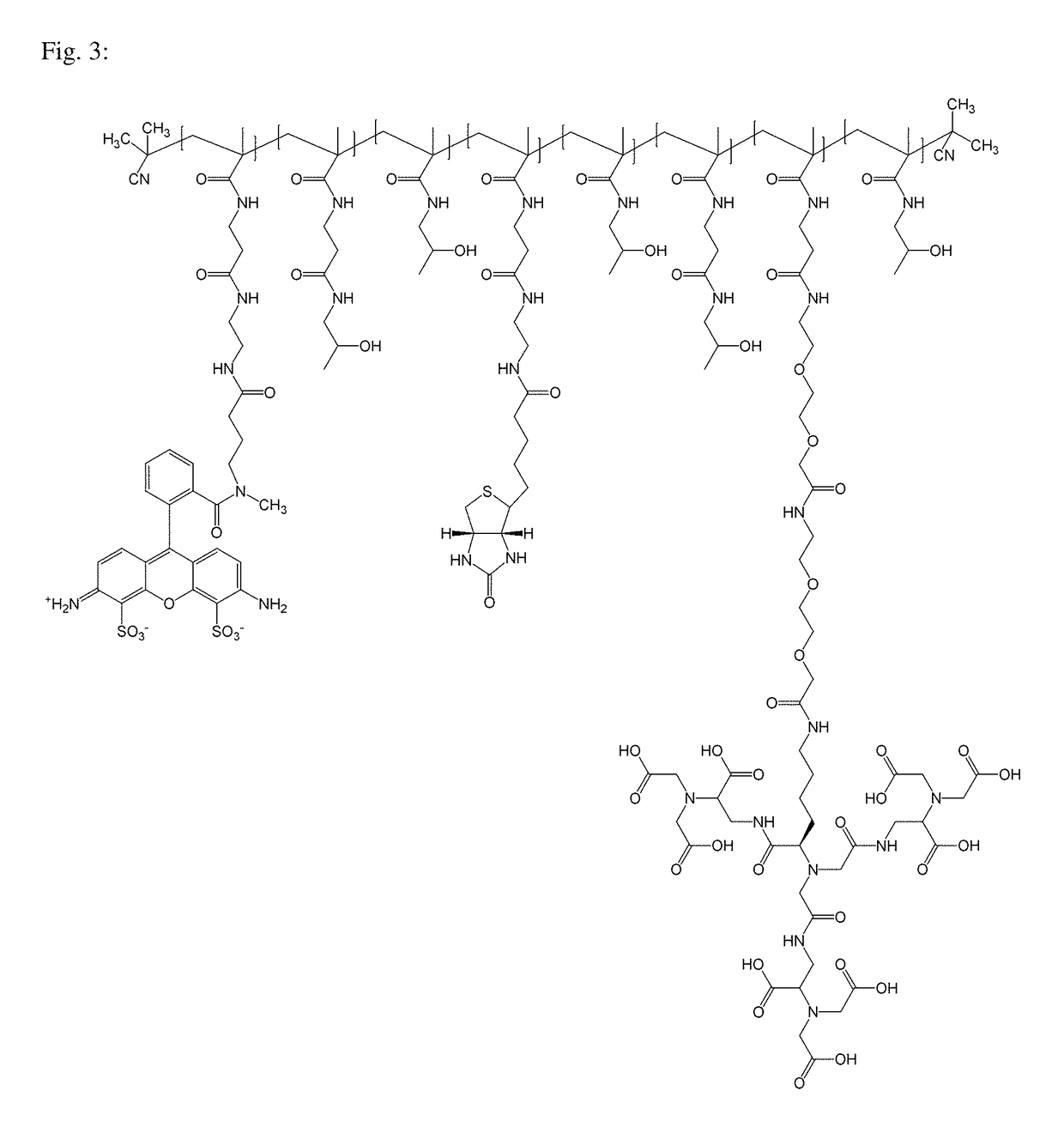Macromolecular conjugates for isolation, immobilization and visualization of proteins
a macromolecular conjugate and protein technology, applied in the field of synthetic macromolecular conjugates, can solve the problems of insufficient sensitivity of many commercially available antibodies against polyhistidine sequences for the quantification of small amounts of proteins labeled with polyhistidine sequences, low sensitivity of polyhistidine sequence dissociation, and high cost of antibody production, so as to reduce storage and handling requirements, facilitate and inexpensively prepare polymeric conjugates, the effect of enhancing chemical stability
- Summary
- Abstract
- Description
- Claims
- Application Information
AI Technical Summary
Benefits of technology
Problems solved by technology
Method used
Image
Examples
example 1
on of Compound A
[0056]Compound A was prepared according to the following scheme:
[0057]
(1) Compound A0
[0058]Compound A0, NH2-triNTA(o-tBu)9: Synthesis of Compound A0 was performed according to published procedure [7], with a small deviation in one step: in a reaction between a derivative of a tricarboxylic acid (derived from lysine), and three monomers of nitrilotriacetic acid, N,N,N′,N′-tetramethyl-O—(N-succinimidyl)uronium tetrafluoroborate (TSTU) was used as the activating agent instead of NHS / EDC, as TSTU provided significantly higher yields.
(2) Compound A
[0059]Compound A, NH2—PEG5-triNTA: Compound A0 (52 mg, 38 μmol, 1.0 eq, purified using HPLC prior to this step) was dissolved in 1 ml of DMF to which 15 mg (38 μmol, 1.0 eq) of Boc-O2Oc-O2Oc-OH linker (Iris Biotech, #BAA1485) was subsequently added in one step. 16 mg (76 μmol, 2.0 eq) of DCC was further added to the reaction mixture and the reaction was left to react for 24 hours at room temperature. The solvent was evaporated ...
example 2
on of Conjugate 1
(1) Preparation of the Polymeric Precursor Poly(HPMA-Co-Ma-β-Ala-TT)
[0061]Monomeric compounds N-(2-hydroxypropyl) methacrylamide (HPMA) and 3-(3-methacrylamido propanoyl) thiazolidine-2-thione (Ma-β-Ala-TT) were prepared according to a published procedure [1, 5]. The polymeric precursor poly(HPMA-co-Ma-β-Ala-TT) was prepared using RAFT-copolymerization (reversible addition-fragmentation chain-transfer). 1.0 g of HPMA (85% mol) was dissolved in 7.3 ml of tert-butanol; 318 mg of Ma-β-Ala-TT (15% mol) dissolved in 1.9 ml of DMSO, 2.42 mg of 2-cyano-2-propylbenzodithioate and 0.90 mg of 2,2′-azobis (2-methylpropionitrile) was added to the solution and the solution was transferred into a polymerization vial. The mixture was purged with argon for 10 min and then the vial was sealed. The polymerization reaction was performed at 70° C. (16 h). The polymeric precursor was isolated by precipitation into acetone:diethyl ether mixture (3:1), filtered, washed with acetone and di...
example 3
on of Conjugate 2
(1) Preparation of Conjugate 2
[0066]The polymeric precursor poly(HPMA-co-Ma-β-Ala-TT) (0.030 mg, Mw=81600 g / mol, 14.6 mol % TT; see Preparation of Conjugate 1), Compound A (3.5 mg) and N-(2-aminoethyl)biotinamido hydrobromide (biotin-NH2) (4 mg) were dissolved in 0.3 ml of DMSO. N,N-diisopropylethylamine (DIPEA) (4.0 μl) was added and the reaction mixture was stirred for 4 hours at room temperature; then, 1-amino-propan-2-ol (2 μl) was added to the solution and the reaction mixture was stirred for 10 min. Then, the polymeric conjugate 2 poly(HPMA-co-Ma-β-Ala-CompoundA-co-Ma-β-Ala-NH-biotin) was isolated by precipitation into acetone:diethyl ether (3:1), filtered, washed with acetone and diethyl ether and dried in vacuum. Polymeric conjugate was purified from low-molecular impurities by column chromatography on Sephadex LH-20 in methanol, precipitated in diethyl ether, filtered and dried in vacuum. The yield of Conjugate 2 was 21 mg. Biotin content 5.53% was determin...
PUM
| Property | Measurement | Unit |
|---|---|---|
| flow rate | aaaaa | aaaaa |
| flow rate | aaaaa | aaaaa |
| weight | aaaaa | aaaaa |
Abstract
Description
Claims
Application Information
 Login to View More
Login to View More - R&D
- Intellectual Property
- Life Sciences
- Materials
- Tech Scout
- Unparalleled Data Quality
- Higher Quality Content
- 60% Fewer Hallucinations
Browse by: Latest US Patents, China's latest patents, Technical Efficacy Thesaurus, Application Domain, Technology Topic, Popular Technical Reports.
© 2025 PatSnap. All rights reserved.Legal|Privacy policy|Modern Slavery Act Transparency Statement|Sitemap|About US| Contact US: help@patsnap.com



